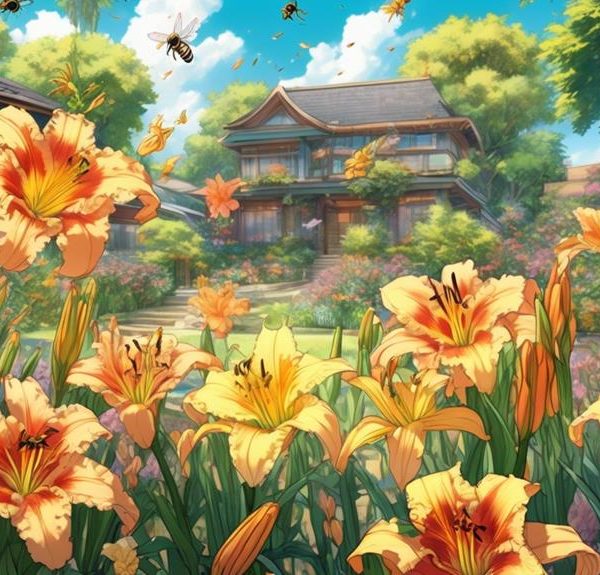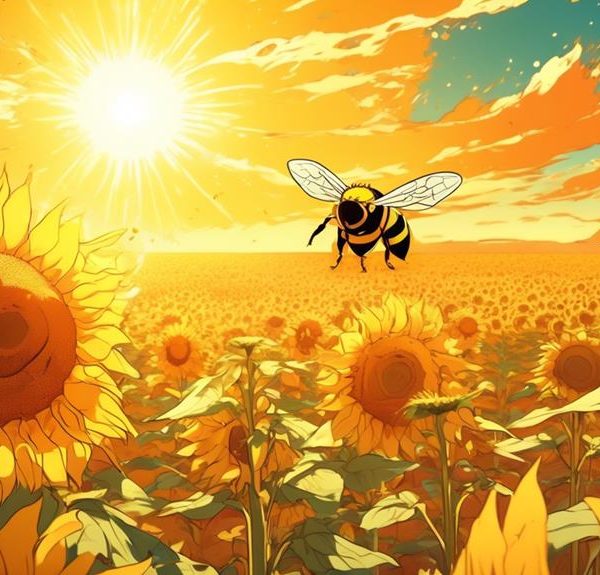Pondering if bees fancy geraniums? Uncover unexpected revelations about their complex relationship that could reshape your gardening approach.
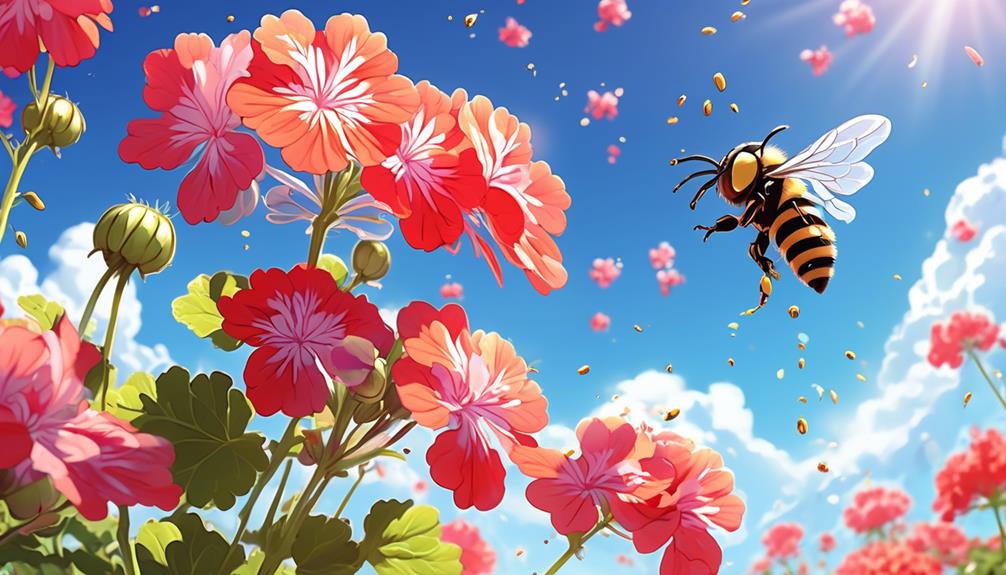
Do Bees Like Geraniums?
You know what they say: 'beauty is in the eye of the beholder'. When it comes to the intricate relationship between bees and flowers, this couldn't be more accurate.
You've probably wondered whether the alluring geraniums that adorn your garden, with their vibrant petals and compelling fragrance, are as captivating to bees as they are to you. While you might think that bees would naturally be drawn to these floral beauties, the reality is a bit more complex.
This brings us to the question: do bees actually like geraniums? As we journey through the fascinating world of bees and geraniums, you'll discover unexpected findings that may lead you to reconsider your gardening strategies.
Key Takeaways
- Bees are attracted to flowers based on their color, shape, scent, and nectar content.
- Geraniums contribute to biodiversity by attracting a variety of pollinators.
- Geraniums have a scientific role in pest management by repelling harmful insects.
- Geraniums attract bees with their fragrance and colorful blooms, providing a rich source of nectar and pollen for bee nutrition and hive sustainability.
Understanding Bees' Attraction to Flowers
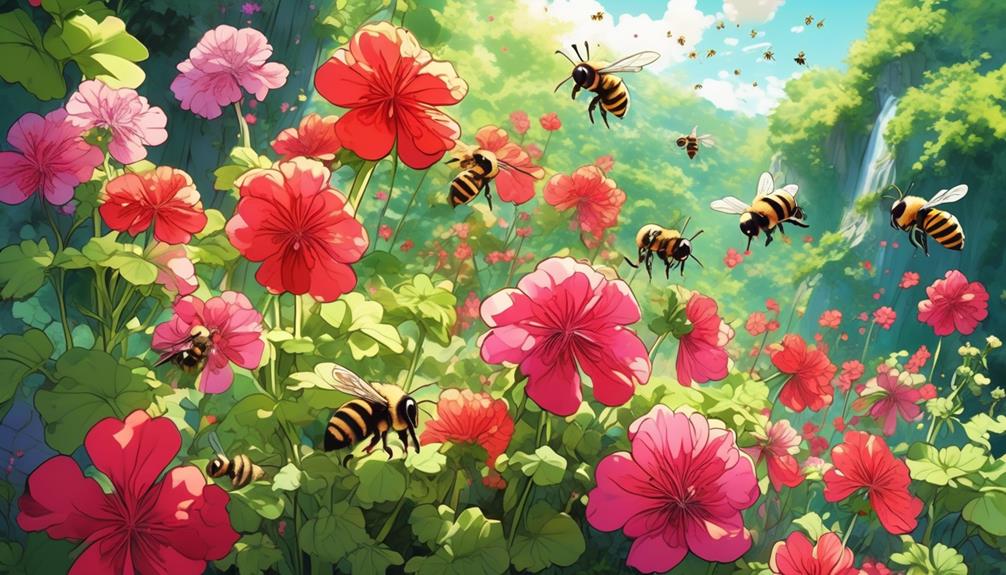
To comprehend why bees may be attracted to geraniums, it's crucial to delve into the complex interplay between bees and flowers, starting with the basic science of pollination. When bees land on a flower, they're not just collecting nectar for food; they're also spreading pollen from the male parts of one flower to the female parts of another, aiding in plant reproduction. This mutualistic relationship benefits both parties: bees get nourishment, and plants get a lift in their propagation efforts.
Now, what attracts bees to certain flowers over others? It's primarily the flowers' color, shape, scent, and nectar content. Bees tend to prefer bright colors like blue, purple, and yellow, which geraniums often exhibit. The shape and scent of the flower also play a role. If a flower's structure makes it easy for the bee to access nectar and pollen, and if its scent signals that it's a good source of food, then it's likely to attract bees.
Understanding this intricate interaction should give you a clearer picture of why bees might be drawn to your geraniums. It's not random; it's a complex dance of nature fueled by mutual benefits.
The Role of Geraniums in Gardening
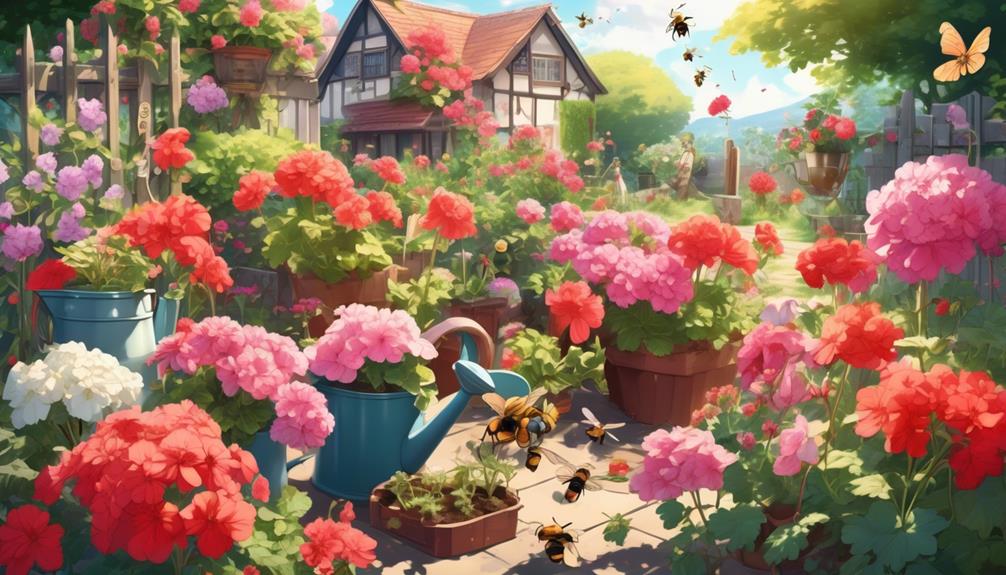
While understanding the attraction of bees to geraniums offers fascinating insights into nature's complex dance, it's equally important to consider the role these vibrant flowers play in your garden. Geraniums aren't just aesthetically pleasing, they're also highly functional.
From a biological perspective, geraniums contribute to biodiversity by attracting a variety of pollinators, including bees, hummingbirds, and butterflies. These pollinators are essential for the fertilization of other plants in your garden. Geraniums also have a unique resilience. They're hardy plants that can thrive in various soil types and weather conditions, making them a reliable choice for gardeners in different climates.
In addition, geraniums have a scientific role in pest management. They produce certain compounds that repel harmful insects, reducing the need for chemical pesticides and contributing to a healthier garden ecosystem.
Moreover, the geranium's bright flowers and diverse colour palette can play a key role in your garden's visual design. They can provide contrast, set a mood, or draw attention to a specific area.
Bees and Geraniums: A Detailed Study
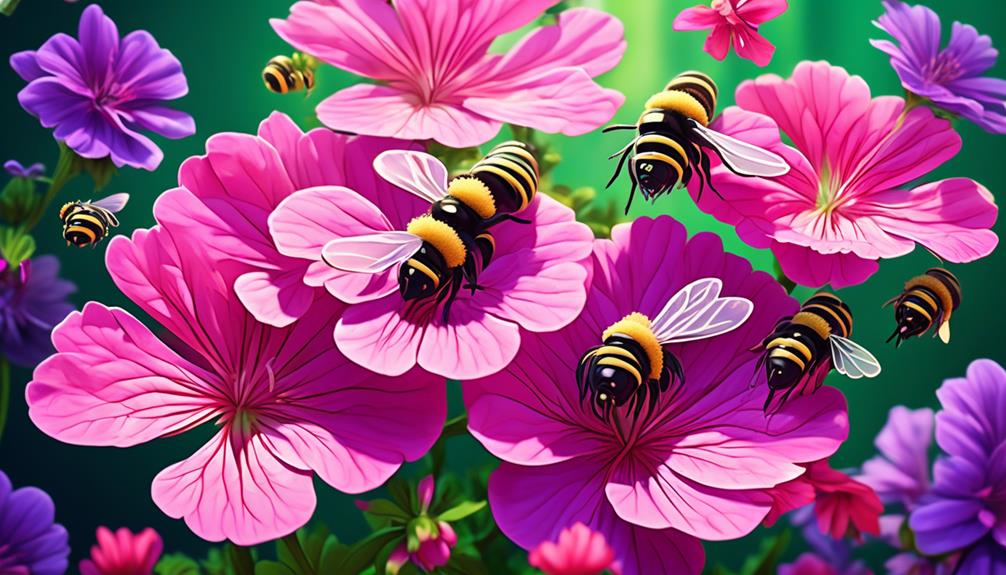
Delving into the intricate relationship between bees and geraniums, you'll find it's a compelling study of nature's delicate balance. Geraniums, known for their vibrant blooms and aromatic leaves, are often visited by bees. But do bees like these flowers?
Scientifically speaking, bees have a preference for flowers that provide them with high-quality nectar and pollen, their primary food sources. It turns out, geraniums aren't top-tier providers of these bee dietary staples. They produce less nectar and pollen compared to other flowers like lavender or sunflowers.
Yet, you'll find bees buzzing around geraniums. Why? Bees, you see, don't just seek volume; they're also after diversity in their diet. Visiting different flower species ensures a balanced nutrient intake. So, while geraniums may not be their favorite, they're still a part of the bee's menu.
Furthermore, geraniums have ultraviolet patterns on their petals, visible only to pollinators like bees. These patterns guide bees to the flower's center, where nectar and pollen reside.
Factors Influencing Bee-Flower Interactions
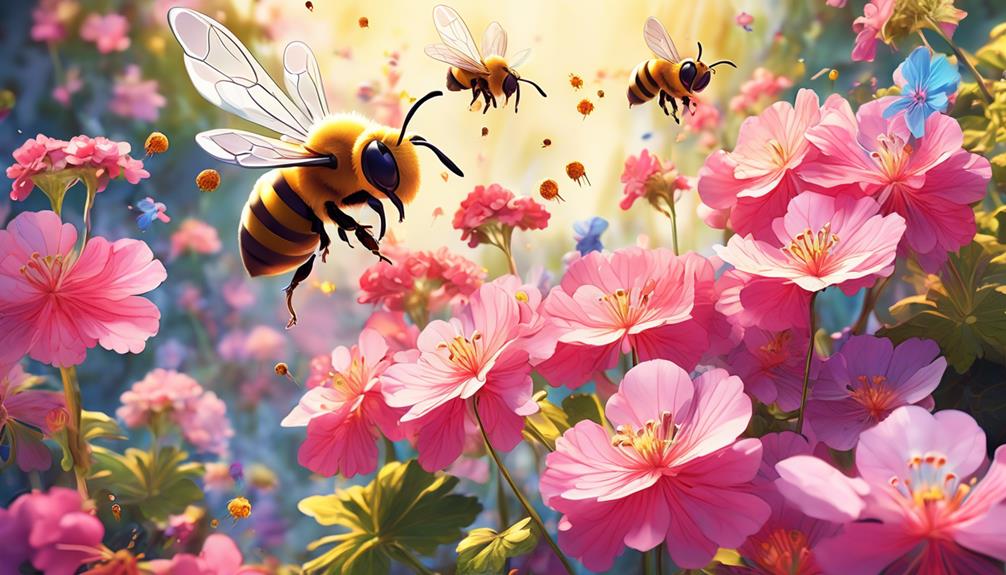
Understanding the nuances of bee-flower interactions isn't just about the bees' dietary needs or the flowers' nectar and pollen production; numerous other factors come into play. You must consider the structural characteristics of a flower, such as its color, shape, and size, which can all significantly influence a bee's preference.
For instance, bees tend to be more attracted to flowers with bright and contrasting colors, as their vision is most sensitive to ultraviolet, blue, and green wavelengths. The flower's shape also plays a pivotal role. Bees prefer flowers with a landing platform they can rest on while foraging.
Moreover, the timing of a flower's bloom can affect bee visitation rates. Bees are active during the day, and hence, flowers that bloom in daylight hours are more likely to be visited.
The presence of predatory insects or birds near a flower can deter bees as well. Finally, environmental factors such as temperature, wind speed, and humidity can impact bee-flower interactions as bees are ectothermic creatures and sensitive to climatic changes.
Understanding these various factors can help you better appreciate the complex interplay between bees and flowers.
Impact of Geraniums on Bee Population
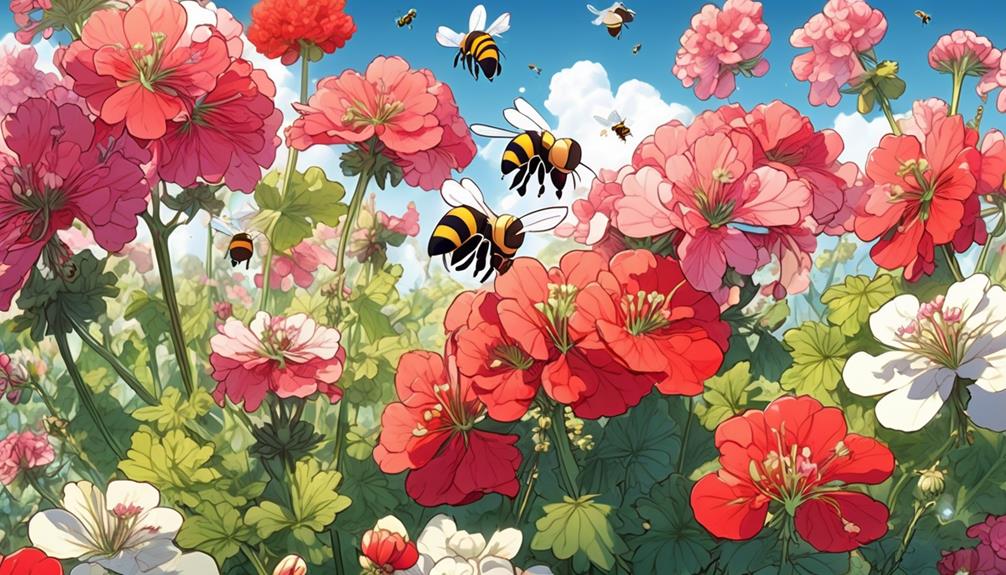
In assessing the role geraniums play in bee populations, it's crucial to note that these vibrant flowers can have a significant impact on bees' foraging patterns and overall survival. Geraniums, with their distinct fragrance and colorful blooms, are known to attract a variety of pollinators, including bees. These flowers not only provide a rich source of nectar but also offer pollen, essential for bee nutrition and hive sustainability.
Scientific studies show that geraniums' nectar and pollen have unique chemical compositions, influencing bees' foraging behaviors. Essentially, these flowers can shape the bees' feeding strategies and, by extension, affect their reproductive success.
However, it's not all rosy. Overreliance on geraniums can make bee populations vulnerable to changes in the blooming periods of these flowers. It's also worth mentioning that some geranium species, particularly those with complex petal structures, can pose foraging challenges to bees, potentially leading to energy loss and reduced foraging efficiency.
Frequently Asked Questions
Is There a Specific Type of Geranium That Bees Are More Attracted To?
You're on the right track. Bees do have a preference when it comes to geraniums. They're especially attracted to the nectar-rich varieties such as the Ivy or Zonal geraniums. These types have bright, open flowers that bees can easily access.
However, it's not just the type, but also the color that attracts bees. They're most drawn to blue, purple, and violet geraniums.
Do Bees Contribute to the Growth of Geraniums in Any Way?
Yes, bees do contribute to the growth of geraniums. As they move from flower to flower, they're actually pollinating the plants.
When a bee lands on a geranium, it picks up pollen on its body and then transfers it to the next flower it visits. This cross-pollination is vital for geraniums' reproduction, and it encourages stronger, healthier plant growth.
What Other Insects Are Attracted to Geraniums and How Does This Affect Bees?
Butterflies, ladybugs, and wasps are also attracted to geraniums. This could affect bees in different ways.
If there's a lot of competition, bees mightn't get as much nectar. But, if those insects are helping to pollinate the geraniums, it could make the flowers more plentiful and beneficial for the bees.
It's a delicate balance. You'd have to observe your own garden to see how these dynamics play out.
How Can Gardeners Encourage More Bees to Their Geranium Plants?
To attract more bees to your geranium plants, you'll need to incorporate diversity in your garden.
Bees are drawn to a variety of colors and scents. Mix geraniums with other bee-friendly flowers like lavender and rosemary.
Also, providing a small water source can help.
Avoid using pesticides, as they're harmful to bees.
Can the Color or Smell of Geraniums Deter Bees?
Yes, the color and scent of geraniums can deter bees.
You see, bees are attracted to blues, purples, and yellows but not to reds or pinks, common geranium colors.
While geraniums do emit a strong scent, it isn't particularly enticing to bees.
Conclusion
So, do bees like geraniums?
Well, it's not that simple. Bees' attraction to flowers is influenced by numerous factors, not just the type of flower. However, studies indicate geraniums don't top their preference list.
While geraniums play a vital role in gardening, their impact on the bee population is minimal.
So, if you're planning a garden with the intention to attract bees, it might be best to consider other flowers alongside geraniums.

